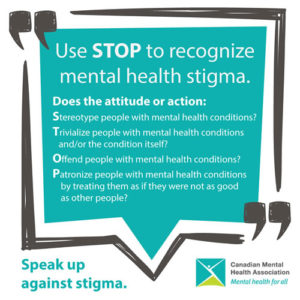The lives of people with mental health conditions are often plagued by stigma as well as discrimination. Stigma is a negative stereotype. Stigma is a reality for many people with a mental illness, and they report that how others judge them is one of their greatest barriers to a complete and satisfying life.
Stigma differs from discrimination. Discrimination is unfair treatment due to a person’s identity, which includes race, ancestry, place of origin, colour, ethnic origin, citizenship, creed, sex, sexual orientation, gender identity, gender expression, age, marital status, family status or disability, including mental disorder. Acts of discrimination can be overt or take the form of systemic (covert) discrimination. Under the Ontario Human Rights Code, every person has a right to equal treatment with respect to services, goods and facilities, without discrimination due to the identities listed above.
Stigma is the negative stereotype and discrimination is the behaviour that results from this negative stereotype. Often, individuals with a mental illness are faced with multiple, intersecting layers of discrimination as a result of their mental illness and their identity. For example, a woman with a mental illness may experience discrimination due to sexism as well as her illness, and a racialized individual may experience discrimination due to racism in addition to their mental illness. In addition, living with discrimination can have a negative impact on mental health.
Media influence on public attitudes
Many studies have found that media and the entertainment industry play a key role in shaping public opinions about mental health and illness. People with mental health conditions are often depicted as dangerous, violent and unpredictable. News stories that sensationalize violent acts by a person with a mental health condition are typically featured as headline news; while there are fewer articles that feature stories of recovery or positive news concerning similar individuals. Entertainment frequently features negative images and stereotypes about mental health conditions, and these portrayals have been strongly linked to the development of fears and misunderstanding.
Impact of negative public attitudes
There are significant consequences to the public misperceptions and fears. Stereotypes about mental health conditions have been used to justify bullying. Some individuals have been denied adequate housing, health insurance and jobs due to their history of mental illness. Due to the stigma associated with the illness, many people have found that they lose their self-esteem and have difficulty making friends. Sometimes, the stigma attached to mental health conditions is so pervasive that people who suspect that they might have a mental health condition are unwilling to seek help for fear of what others may think. Experiences of stigma and discrimination is one of their greatest barriers to a satisfying life.
What you can do to stop stigma and discrimination
Use person-first language which focuses on the individual, not on the substance use. Language used is an important factor in reducing stigma and breaking down negative stereotypes associated with substance use disorders. By using non-stigmatizing language, those who are experiencing challenges may experience fewer barriers to accessing supports.
The following guide includes some suggestions of person-first language in mental health:
| Common / outdated terms | Person-first language |
| Mental health disorders |
Mental health issues, conditions or illnesses
|
| Individuals “struggling” or “suffering from”
or having a mental illness, mental health condition or issue |
Individuals living with mental illnesses, mental health condition or issue |
| Committed Suicide, “suicided”,
or successful / unsuccessful suicide |
Died by suicide
Attempted suicide |
| Mental illnesses | A mental illness (or specify specific disorder, rather than generalize by using the term “mental illness” to capture all mental illnesses.) |
| Mentally ill person
Someone who is bipolar |
Someone who has a mental illness.
Someone who is living with bipolar disorder. |
| Patient / Client | People with lived experience or individuals we serve |
| Addict / Substance abuser | He/she has a substance use condition.
He/she has lived experience of substance use |
CMHA Ontario has also developed a one page primer on talking about substance use to help.
Use the STOP criteria to recognize attitudes and actions that support the stigma of mental health conditions. It’s easy, just ask yourself if what you hear:
- Stereotypes people with mental health conditions (that is, assumes they are all alike rather than individuals)?
- Trivializes or belittles people with mental health conditions and/or the condition itself?
- Offends people with mental health conditions by insulting them?
- Patronizes people with mental health conditions by treating them as if they were not as good as other people?
If you see something in the media which does not pass the STOP criteria, speak up! Call or write to the writer or publisher of the newspaper, magazine or book; the radio, TV or movie producer; or the advertiser who used words which add to the misunderstanding of mental illness. Help them realize how their words affect people with mental health conditions.
Start with yourself. Be thoughtful about your own choice of words. Use accurate and sensitive words when talking about people with mental health conditions.
